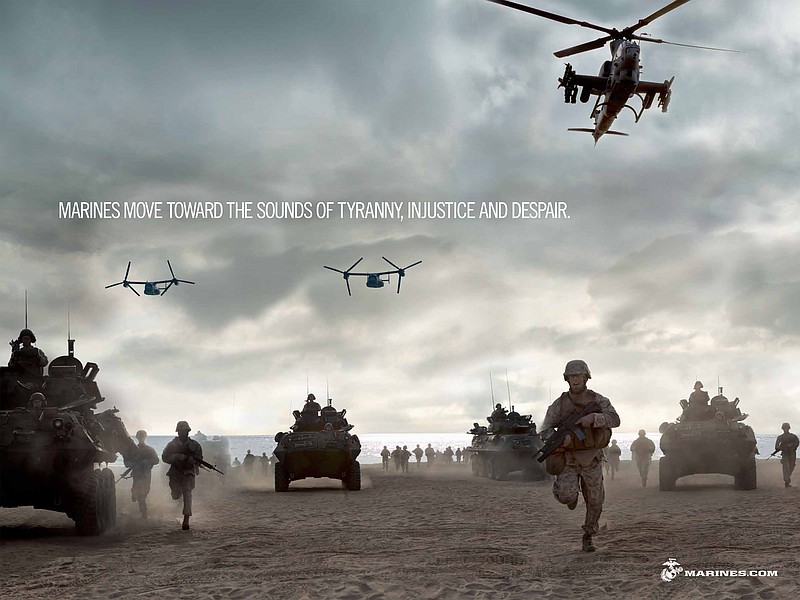WASHINGTON (AP) - They've long been known as devil dogs, leathernecks and "the first to fight." But U.S. Marines, with their self-described expertise in "killing people and breaking things," now want to promote their kinder side as well.
A new Marine Corps advertising campaign starting this weekend takes its cue from research showing today's recruit-age generation is interested in helping people. So the campaign is crafted to show Marines not only as warriors but as humanitarians and peacekeepers; not only as courageous but also as compassionate.
Photos and videos to be distributed on television, in American movie theaters, on YouTube and elsewhere show Marines talking with children; bringing food, water and medical supplies to Haitian earthquake victims, and clearing rubble from a tsunami-devastated Japanese village. These missions aren't a new role for the Marines, but they are ones the force expects to do more of as it's freed from a decade of fighting land wars in Iraq and Afghanistan and returns to its seafaring, expeditionary roots.
Entitled "Toward the Sounds of Chaos," the campaign seeks to explain that in an uncertain world, Marines "need to be ready to engage in whatever activity our country needs us to engage in," Brig. Gen. Joseph L. Osterman, head of the Marine Corps Recruiting Command, said in a recent interview.
"That may go all the way from a combat-type environment, as we've been doing for the last 10 years, to what we did before ... emergent chaotic situations ... catastrophes ... natural disasters or failed-state-type situations where people need help," he said.
The smallest of the service branches, at 202,000, the Marine Corps trains and equips itself with the aim of being light and agile enough to get to any crisis on a moment's notice. They sometimes call themselves "The 911 Force," at the ready to restore order, come to the rescue or evacuate those in danger. A Marine in one of the new advertising videos runs toward an unidentified city under a smoke-filled sky amid sounds of people screaming.
"There are a few who move toward the sounds of chaos ... toward the sounds of tyranny, injustice and despair," a voice says. "Which way would you run?"
The question is a subtle appeal to the generation known as millennials, who said in a survey they believe in giving back to society, voting in national elections and "helping people in need, wherever they may live," said Marshall Lauck, director of the Marine Corps' advertising account at JWT ad agency.
The JWT ad agency does year-round research and periodic larger efforts with the Corps to keep an eye on what the pool of potential American recruits is thinking. It found in the late 2010 survey of 17- to 24-year-olds that roughly 70 percent believed helping others was essential to being a good citizen today.
Only 31 percent of the same 5,000 surveyed thought serving in the military was important to being a good citizen.
"We have a large number of young people who are very interested in doing good ... yet they don't necessarily realize that the military in general and the Marine Corps in particular is a great way to do that," said Lauck, a former Marine.
The survey included another 5,000 people the military calls "influencers," parents, coaches, teachers and similar role models. Many said they had a very favorable view of the military but did not respond in the same high numbers on whether they would recommend the services to the young people in their lives.
The new campaign will launch during the March Madness college basketball tournament.
All the services use recruiting ads and all do some kinds of humanitarian missions. But the current "Army Strong" campaign, started in 2006, focuses on the development of the individual soldier. The Navy campaign started in 2009 calls the service "A Global Force for Good." Some of the Air Force's "It's Not Science Fiction" ads have a slick Hollywood feel and are used to show off technologies, like remotely piloted aircraft, that are used today but were considered fantasy only years ago. It wasn't immediately clear whether any other services plan changes to their campaign changes any time soon.
Though spending can fluctuate over the years, the Marine Corps likes to budget about $100 million annually for ads and some other recruiting costs.
It cost about $3.2 million to produce the new ads for TV, print and the online effort, Caldwell said.
Of course, many need no prompting to join the Corps, and part of the recruiting dynamic is managing expectations. There are a lot of young men and women out there who want to join specifically for "that adventure and action" they see in combat operations, Osterman said. "So we want to make sure that they understand that it's still going to be a very busy world in front of us, but more on responding to chaos ... than to a traditional combat role."
The new campaign has plenty for the gung-ho to like. There are familiar warrior scenes of troops on the go, landing on beaches, firing weapons, dropping bombs. Some of the video was borrowed from Marines who shot it themselves in overseas missions, Caldwell said.

